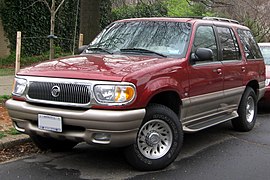Mercury (automobile)
 | |
| Type | Division |
|---|---|
| Industry | Automotive |
| Founded | November 4, 1938 |
| Founder | Edsel Ford |
| Defunct | January 4, 2011 |
| Fate | Defunct |
| Headquarters | Dearborn, Michigan , U.S. |
Key people | Edsel Ford, founder |
| Products | Automobiles |
| Parent | Ford Motor Company |
Mercury is a defunct division of the American automobile manufacturer Ford Motor Company. Created in 1938 by Edsel Ford, Mercury was marketed as an middle priced brand for nearly its entire existence, bridging the price gap between the Ford and Lincoln model lines. Competing against Oldsmobile within General Motors, Mercury also competed most directly against Chrysler's DeSoto, Hudson and Studebaker.
From 1945 to its closure, Mercury was half of the Lincoln-Mercury Division of Ford, forming a combined sales network distinct from Ford. Through the use of platform sharing and manufacturing commonality, Mercury vehicles shared components and engineering with Ford or Lincoln (or both concurrently), serving as counterparts for vehicles from both divisions. Lincoln-Mercury also served as the sales network for Continental (1956–1960), Edsel (1958–1960) and Merkur (1985–1989).
In 2010, Ford Motor Company announced the closure of the Mercury brand in an effort to focus on the Ford and Lincoln brands, ending production at the end of 2010.[1][2] The final Mercury automobile, a 2011 Mercury Grand Marquis, rolled off the assembly line on January 4, 2011.[3] Mercury remains an active, registered trademark of Ford.[4]
History[]
This section needs additional citations for verification. (June 2021) |
During the mid-1930s, Ford Motor Company realized they needed to introduce another brand to offer similar products both of its largest competitors provided, despite the continuing success of its new Ford DeLuxe V8-powered product. In contrast to the comprehensive line of brands from General Motors (seven) and Chrysler Corporation (four), in 1935, Ford offered only its namesake brand and Lincoln Motor Company cars. One of the most expensive vehicles built and sold in the United States, the Lincoln Model K was rivaled in price by the Cadillac V-12 and V-16, the Packard Eight, the Chrysler Imperial Eight, and the Duesenberg Model J.
As a solution, Ford launched its own version of the late 1920s General Motors Companion Make Program, leading the company to expand from two nameplates to five by the end of the decade. For 1936, Ford introduced the Lincoln-Zephyr sub-marque of Lincoln, giving the line a V12 car to compete against the LaSalle and Buick, the Chrysler Airstream and Airflow, and the Packard One-Twenty. For 1938, Ford gained a sub-marque of its own with the higher-price De Luxe Ford, a V8 car with model-specific interior and exterior trim.
In 1937, Edsel Ford began work on Mercury as the first completely new Ford Motor Company brand.[5] While the nameplate was briefly used by Chevrolet for 1933 (Chevrolet Mercury), the Roman god name was personally selected from over 100 potential model and marque names.[5][6] It wasn't the first time the name "mercury" had been used for an automobile. There were seven separate companies that used the name from 1903 until 1923 when each company failed within two years after opening for business, including a manufacturer of steam powered cars in San Francisco, California, and the Mercury Cyclecar Company, a manufacturer of cyclecars at 807 South Scotten Street in Detroit from 1913-1914.[7]
In November 1938, the Mercury Eight in four body styles were introduced at the New York Auto Show by Edsel Ford, introducing a two-door and four-door sedan, along with a two-door convertible and a two-door sedan with a trunk attached; body design was overseen by E.T. 'Bob' Gregorie.[5] While similar in concept to the modestly restyled De Luxe Ford, the V8 Mercury was an all-new car-sized between Ford and the Lincoln-Zephyr.[5]
1939–1940s[]
For the 1939 model year, Mercury made its debut with a namesake vehicle line as a completely new design. Sized between Ford and Lincoln, Mercury adopted a 116-inch (2,900 mm) wheelbase (four inches [100 mm] longer than Ford, six inches [150 mm] shorter than the Lincoln-Zephyr) with a body six inches (150 mm) wider than Ford. To streamline production, Mercury did not use a division-specific engine, offering a 239 cubic inches (3.92 l) version of the Flathead V8 (producing 95 hp [96 PS; 71 kW]).
Over 65,800 1939 Mercurys were sold, at a starting price of US$916 ($17,042 in 2020 dollars [8]).[9][10] Following the popularity of Mercury, Ford revised its branding, with De Luxe Ford repackaged as a trim line; following the 1940 discontinuation of the Lincoln Model K, all Lincolns were Lincoln-Zephyrs (including the Continental).
For 1941, as part of its first redesign, the Mercury adopted the Mercury Eight nameplate used in sales literature. To consolidate development and production, the Mercury Eight shared much of its bodyshell with Ford, distinguished by its 4-inch (100 mm) longer wheelbase. To further separate the two model lines, the Eight was given a model-specific grille, exterior and interior trim, and taillamps. For the first time, the Eight was offered as a wood-bodied station wagon.
For the shortened 1942 model year, 24,704 Mercury vehicles were produced.[11] Before production was suspended, several major changes were introduced. For the first time, the Flathead V8 was offered with 100 hp (100 PS; 75 kW) in standard form. As part of an interior redesign, the Eight received a dashboard configured similar to the Lincoln Zephyr. To compete with Fluid Drive (Chrysler) and Hydramatic (General Motors), the 1942 Mercury offered Liquamatic, the first semi-automatic transmission offered by Ford Motor Company.[12] Shared with Lincoln, Liquamatic proved complex and unreliable, with many systems replaced by conventional manual transmissions.[12]
Following the rise of Henry Ford II as Ford president, on October 22, 1945, Ford Motor Company merged Mercury and Lincoln Motor Company into a combined Lincoln-Mercury division.[13] In an effort to fully establish a brand structure within Ford Motor Company, Lincoln-Mercury functioned as a combined division while marketing both namesake model lines. While the Lincoln-Zephyr reentered production, the Zephyr nameplate was discontinued (Lincoln discontinued the Continental after 1948).
On November 1, 1945, the first 1946 Mercury Eights rolled off the assembly line.[13] In line with Lincolns, Fords, and virtually all American-manufactured vehicles, 1946 production was functionally unchanged from 1942.[13] The grille underwent a minor redesign, reintroducing vertically-oriented trim. As few were installed before production ended, the unpopular Liquamatic transmission did not return as an option.[12] Through 1947 and 1948, few major changes were made.
In 1949, Ford Motor Company launched its first all-new post-war designs for all three of its model lines. To gain exposure for both Lincoln-Mercury brands, the Lincoln was given the same bodyshell as the 1949 Mercury Eight, largely distinguished by headlight and grille designs; Mercury and Lincoln would feature separately-trimmed interiors. Mechanically, each brand offered its own version of the Ford Flathead V8.
For many years after its production, the 1949–1951 Mercury Eight (most commonly in a two-door form) would develop a following as a street rod, making an appearance in several films.

1939 Mercury Model 99A

1941 Mercury Eight coupe

1946 Mercury station wagon (Marmon-Herrington 4x4 conversion)

1947 Mercury Town Sedan
1949 Mercury Eight sedan
1950s[]
The 1949 redesign of the Mercury model line proved successful, with the division increasing its sales six-fold over 1948, becoming the sixth-most popular brand in the United States.[14] In contrast to medium-price brands from Chrysler and General Motors (or independents such as Nash, Hudson, or Packard), Mercury continued to offer the Eight as its sole model line.
For 1950, the Monterey name made its first appearance, denoting a special edition of two-door coupes (alongside the Lincoln Lido and Ford Crestliner). Intended to compete against the hardtop coupes from General Motors, the Monterey simulated the appearance of a convertible through the use of a canvas or vinyl roof (though with a pillared roofline).[15] During the year, the one-millionth Mercury vehicle was produced.[16] In 1951, Mercury regained an automatic transmission option (for the first time since the 1942 Liquamatic), with the "Merc-O-Matic" 3-speed automatic (a rebranding of Ford Cruise-O-Matic).[17]
For 1952, Mercury redesigned its model line, with two nameplates replacing the Eight. The Monterey returned as a distinct model line, slotted above the base-trim Custom; both shared bodies with Lincoln. In 1953, the expansion of the model line proved successful; after emerging from a war-depressed market, Mercury nearly doubled in sales, ranking eighth.[15] While Mercury would have subsequently higher yearly sales, at 5%, this is the largest market share ever held by the division.[16] For 1954, Ford replaced the long-running Flathead V8 (dating from 1932) with an overhead-valve Y-block V8, with Ford and Mercury receiving their own versions of the engine.[15] As a submodel of the standard Monterey hardtop, the Monterey Sun Valley was introduced, featuring a fixed-panel acrylic glass sunroof. While offering an open-air interior, the Sun Valley was difficult to market in warm-weather climates (as the glass panel warmed the interior to uncomfortable temperatures).[15]
In 1955, Mercury underwent a redesign of its model line. While again sharing much of its bodyshell with Lincoln, the division adopted the three-model range of Ford. As its premium model range, the Montclair was introduced above the Monterey (including the Sun Valley glass-top hardtop, for its final year). The revision proved successful, as Mercury reached its then-highest sales.[15] The divisional structure of Ford was revised; Lincoln-Mercury was split (largely to accommodate the formation of the Continental division)[16] In 1956, Mercury renamed the Custom the Medalist (to avoid confusion with the Ford Custom).
For 1957, Mercury redesigned its model range, with a 122-inch (3,100 mm) wheelbase sized between Ford and Lincoln.[18] In a move upmarket, the slow-selling Medalist was discontinued, with the Monterey becoming the standard Mercury line. Previewed by the 1956 XM-800 concept car, the Turnpike Cruiser (the pace car of the 1957 Indianapolis 500) was slotted above the Montclair, distinguished by its quad headlamps and retractable rear window. In line with Ford, Mercury station wagons became a distinct model line, with the Commuter, Voyager, and Colony Park; all Mercury station wagons were hardtops.
In 1958, to accommodate the introduction of Edsel, Ford revised its divisional structure, with Mercury, Edsel, and Lincoln forming a combined division (M-E-L).[16] The Edsel Citation and Edsel Corsair shared their chassis (and roofline) with Mercury, with the entire division overlapping Mercury in price (a key reason behind its failure). The Park Lane was introduced as a flagship model line on a 125-inch (3,200 mm) wheelbase (with the Turnpike Cruiser becoming part of the Montclair line). Shared with Lincoln (and the Ford Thunderbird), Mercury introduced a 430 cubic inches (7.0 l) "Marauder" V8; optional on all Mercurys, a 400 hp (410 PS; 300 kW) "Super Marauder" version became the first mass-produced engine to be rated at 400 hp (410 PS; 300 kW).
For 1959, Mercury underwent a revision of its body, expanding to a 126-inch (3,200 mm) wheelbase.[19] Coinciding with the discontinuation of the Edsel Corsair and Citation, Mercury produced its own body and chassis (for the first time since 1940). The division pared several slow-selling model lines, including the Turnpike Cruiser and Voyager; the two-door Commuter was in its final year.
As with many medium-price brands, the Mercury brand was hit hard by the economy of the late 1950s. While remaining eighth in sales from 1957 to the end of the decade,[18][19] Mercury saw a 60 percent drop in sales in 1958, outranked by Rambler in sales. While outselling the heavily-marketed Edsel by over a two-to-one margin;[19] it would take nearly 1958 and 1959 combined to match the 1957 sales total.[19]
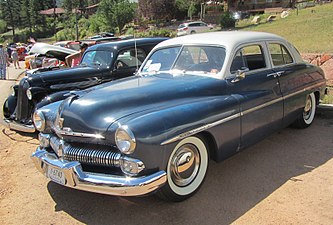
1950 Mercury Eight 4-door
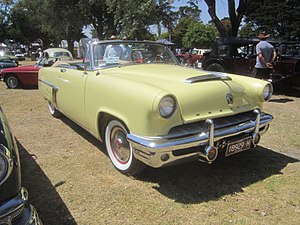
1952 Mercury Monterey convertible
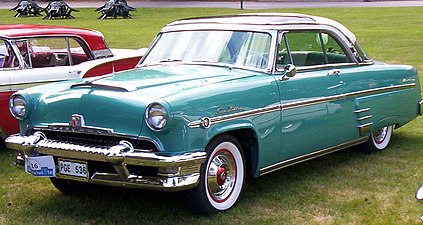
1954 Mercury Monterey Sun Valley (Ford Crestline Skyliner)
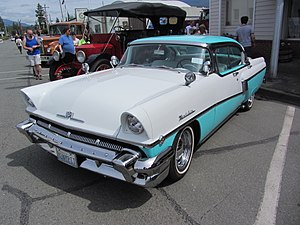
1956 Mercury Montclair 4-door hardtop
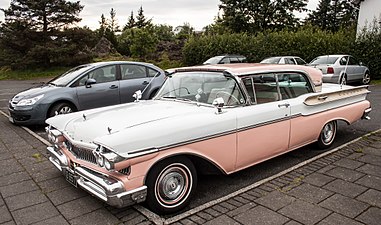
1957 Mercury Turnpike Cruiser 4-door hardtop

1959 Mercury Colony Park
1960s[]
While affecting the American automotive industry as a whole, the economic recession of the late 1950s had the harshest impact upon medium-priced brands. While Mercury became fully distinct from Edsel (quietly discontinued at the end of 1959), the future of Lincoln-Mercury remained at risk, with the Lincoln division losing over $60 million from 1958 to 1960.[20] In response, several Ford executives (led by Ford President Robert McNamara), proposed ending the losses by streamlining Ford Motor Company down to its namesake division.[21] McNamara (prior to leaving Ford to become Secretary of Defense) allowed the division to remain, under several conditions.[21] Lincoln reduced its model line down to the Lincoln Continental (with a much smaller exterior footprint); to establish model continuity, the division shifted to a nine-year model cycle (the longest for an American brand).[22] To downsize its body and lower production costs, Mercury was to adopt the Ford body (on its own wheelbase).[23] In place of the five divisional bodies produced in 1958 (Ford, Lincoln/Continental, Mercury, large Edsel, small Edsel), Ford trimmed its full-size range to two for 1961 (Ford/Mercury, Lincoln).
For 1960, Mercury entered the compact car segment (a year before Buick, Oldsmobile, and Pontiac) with the introduction of the Mercury Comet. Originally developed for Edsel, the Comet was sold without Mercury divisional badging until 1962 (similar to the original Valiant from Plymouth). The Mercury counterpart of the Ford Falcon (stretched to a 114-inch [2,900 mm] wheelbase), the Comet was given four headlights instead of two; the standard engine was a 90-horsepower (91 PS; 67 kW) inline-6 (becoming the first Mercury ever sold without a V8 engine).
For 1961, Mercury introduced all-new full-size cars, shifting from a division-exclusive chassis to a 120-inch (3,000 mm) wheelbase version of the Ford Galaxie. The Montclair and Park Lane were withdrawn in favor of the Monterey, Commuter, and Colony Park. The Mercury Meteor was introduced as an entry-level full-size range; as with the Comet, the Meteor was originally developed as an Edsel before its closure.
For 1962, Mercury revised its model line, matching it closer to Ford. To eliminate overlap with the Monterey, the Meteor nameplate was adopted for an intermediate, giving Mercury a counterpart of the Ford Fairlane. For non-station wagons, Mercury introduced "S" sub-models to market sportier content; along with higher performance powertrains, the option packages included full-length consoles, floor shifters, and bucket seats with the S-22 (Comet), S-33 (Meteor), and S-55 (Monterey).
For 1963, two different rooflines were introduced on the Monterey as an option. Similar to the Turnpike Cruiser and 1958–1960 Continental, Mercury offered a "breezeway" reverse-slant rear window. In stark contrast to the breezeway roofline, Mercury offered the "Marauder" fastback roofline (shared with the Ford Galaxie 500XL); its aerodynamics helped Mercury gain ground in stock-car racing.[citation needed]
By the middle of the decade, the Mercury division had secured its future. No longer entangled with the failure of the Edsel brand, the brand competed closely against Buick, Oldsmobile, the middle of the Chrysler range, and the top of American Motors range. For 1964, the full-size range underwent a revision; the Montclair and Park Lane were reintroduced above the Monterey, with the Meteor and S-models withdrawn. For 1965, the full-size models underwent a redesign; while still sharing the underpinnings of the Ford Galaxie, many styling elements were adopted from Lincoln, with advertising marketing them as "built in the Lincoln tradition".
For 1966, the Comet shifted into the intermediate segment, effectively replacing the Meteor. For full-size Mercurys, multiple rooflines were gradually phased out, with the fastback Marauder roofline discontinued in 1966 and the Breezeway roofline discontinued in 1967. After a two-year hiatus, the S-55 returned for 1966.
In 1967, Mercury introduced its two most successful nameplates, the Cougar and Marquis. Introduced as a counterpart of the Ford Mustang, the Cougar was intended to bridge the gap between the Mustang and Ford Thunderbird; the Cougar would go on to become the counterpart of the Thunderbird for 20 years. The counterpart of the Ford LTD, the Marquis was developed as a competitor of the Chrysler New Yorker, the Oldsmobile Ninety Eight, and Buick Electra. In various forms, the Marquis nameplate would survive until the closure of Mercury in 2011. For 1967 it was available as a formal-roof 2 door hardtop. Mercury's most luxurious 4 door model for 1967 was the Brougham, equipped like the Marquis, and available as a sedan or a hardtop. It featured a "Breezeway" rear window that could be lowered 2 inches, and effectively replaced the blocky Breezeway roofline used on earlier Mercurys.
For 1968, the Mercury model range underwent several revisions. The Mercury Montego replaced the Comet as the intermediate model range (based on the Ford Torino). Introduced in 1964 as a performance-oriented submodel of the Comet, the Mercury Cyclone became a standalone model range slotted above the Cougar; the aerodynamically-optimized Cyclone Spoiler II was homologated as the 1969 Mercury entry for NASCAR.
For 1969, the full-size Mercury line was given an all-new body and chassis. While again shared with Ford, the Mercury model line underwent a major revision, with the Marquis expanded to a full model range (alongside the Ford LTD) and the Colony Park no longer marketed as a separate series; the Park Lane and Montclair were discontinued. Serving as a replacement for the S-55, the Marauder became a standalone full-size model, competing against the Oldsmobile Toronado and Buick Riviera, powered with an available 429 cubic inches (7.03 l) V8. To differentiate the Marquis from the Ford LTD, Mercury introduced hidden headlights for the model line. While still based on the Ford Mustang, the Cougar was available as a pony car or a muscle car, with an "Eliminator" performance package with an available 428 Cobra Jet V8.

1961 Mercury Meteor 2-door hardtop
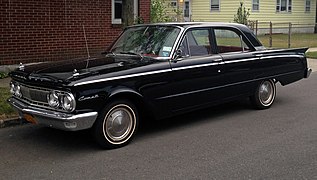
1962 Mercury Comet 4-door sedan
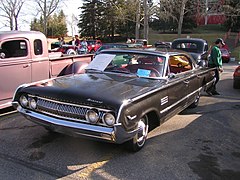
1964 Mercury Monterey Marauder

1966 Mercury S-55

1967 Mercury Cougar
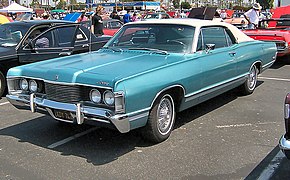
1968 Mercury Marquis
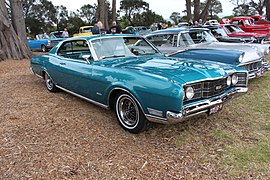
1969 Mercury Montego
1970s[]
During the 1970s, the product line of the Mercury division was influenced by several factors that affected all American nameplates. While sporty cars would not disappear from the division, Mercury refocused itself further on building high-content vehicles.
1970 marked the entry of Mercury into the subcompact segment. In place of selling its own version of the Ford Pinto, the division commenced captive imports of the Capri (European Ford Capri) from Cologne, Germany. Slightly larger than the Pinto, the Capri was marketed as a compact sports car rather than an economy car, becoming the first Ford Motor Company car in North America sold with a V6 engine. While sold through Lincoln-Mercury, Capris sold in North America from 1970 to 1978 had no divisional identification.
For 1971, Mercury gradually distanced itself away from performance vehicles. The Marauder and Marquis convertible were discontinued, with the Brougham name making its return. Restyled along with the Mustang, the Cougar was repackaged as a competitor of the A-body coupes (Chevrolet Monte Carlo, Oldsmobile Cutlass Supreme, Pontiac Grand Prix) of General Motors. Slotted below the Montego, the Comet made its return as a counterpart of the Ford Maverick (sharing much of its chassis underpinnings with the 1960 Comet).
At the other end of the performance spectrum from the Capri, Lincoln-Mercury began imports of the De Tomaso Pantera in 1971. Assembled in Modena, Italy, the Pantera was a two-door, mid-engine coupe powered by a 330 hp (330 PS; 250 kW) Ford 351 cubic inches (5.75 l) V8.
For 1972, the intermediate Montego line (based on the Ford Gran Torino) was redesigned with a body-on-frame chassis, creeping into full-size dimensions. After years of losing market share to the Cougar, the Cyclone was quietly discontinued.
The 1973 model year brought major functional changes to the Mercury line, the fuel crisis notwithstanding; in various forms, all Mercury cars were given 5-mph bumpers. The Marquis and Monterey were given an exterior update, adopting a "pillared hardtop" roofline (frameless door glass supported by a thin B-pillar). As American manufacturers shifted away from convertibles, the final convertible produced by Ford Motor Company during the 1970s was a 1973 Mercury Cougar.
1974 marked several significant changes throughout the Mercury model range, transitioning towards higher-content model lines. The Cougar underwent a redesign, shifting from the Mustang chassis to the Torino/Montego chassis, becoming the counterpart of the Ford Elite; in what would later set the design precedent for the model line for over two decades, the Cougar was styled as a Mercury version of the Ford Thunderbird. The Montego saw a revision to its model range, as its fastback body style was discontinued.
For 1975, the Mercury model range underwent a series of transitions. Following the discontinuation of the long-running Monterey, the Marquis became the sole full-size Mercury nameplate; to expand the model range, a new Grand Marquis was slotted between the Marquis Brougham and the Lincoln Continental. Intended as the successor for the Comet, the Monarch led to a completely new market segment: the luxury compact car. The model line was met with success, with examples used as personal cars among Ford executives (including Henry Ford II). Following the 1974 discontinuation of its engine, Lincoln-Mercury ended its sales of the DeTomaso Pantera.
1976 saw the expansion of the smallest end of the Mercury model line. Introduced in Canada in 1975, the Bobcat was the Mercury counterpart of the Ford Pinto, sharing its coupe, hatchback, and station wagon body styles. The Capri was restyled with a hatchback and was renamed the Capri II. The Capri II (devoid of any divisional branding) became the second most-imported car in the United States (behind the Volkswagen Beetle).
For 1977, Mercury made significant revisions to improve sales to its intermediate model range (its slowest-selling models). While technically a mid-cycle model update, the Montego was replaced by the Cougar, with the latter offering sedan and station wagon body styles for the first time. The Cougar base coupe, sedan, and wagon were counterparts of the Ford LTD II, with the Cougar XR-7 hardtop becoming a counterpart of the Ford Thunderbird. The revision was well-received, as Cougar sales nearly tripled. In contrast to the downsized model ranges introduced by General Motors, the 229-inch (5,800 mm) long Marquis/Grand Marquis was powered by a 460 cubic inches (7.5 l) V8 (the second-largest displacement engine used in an American automobile).
1978 commenced the modernization of the Mercury model range, marked by the introduction of the Zephyr compact, replacing the Comet. The counterpart of the Ford Fairmont, the Zephyr marked the introduction of the Fox platform, a rear-wheel drive chassis architecture that underpinned some compact and mid-size Ford and Lincoln-Mercury vehicles from the 1970s into the early 2000s. After ending the importation of the Capri II in late 1977, leftover examples were sold through the 1978 model year. Of the 580,000 vehicles sold; nearly four out of every ten 1978 Mercurys were Cougars.
For 1979, Mercury continued its modernization; as the division shifted away from performance vehicles at the beginning of the decade, the fuel crises of 1973 and 1979 sparked the decline of the landyacht. Two years after General Motors downsized its full-size model lines, Mercury introduced a downsized Marquis; while nearly matching the Cougar sedan in exterior footprint, the 1979 Marquis gained interior space over its 1978 predecessor. The Capri made its return, shifting from German-produced captive import to counterpart of the Ford Mustang; for the first time, the Capri adopted Mercury divisional branding. Bolstered by the redesign of the Marquis and the popularity of Cougar XR7, the Mercury brand reached its all-time sales peak, with nearly 670,000 vehicles sold.[24]
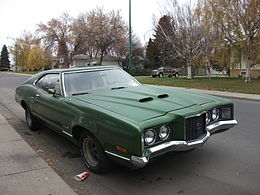
1972 Mercury Montego GT
1973 Mercury Comet
1975 Mercury Grand Monarch Ghia

1975–1976 Mercury Cougar XR-7
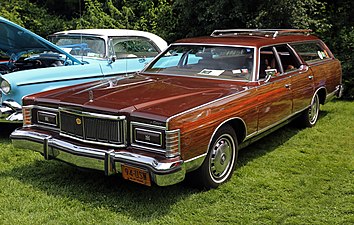
1978 Mercury (Marquis) Colony Park

1978 Mercury Bobcat

1976–1978 Capri II
1980s[]
As Lincoln-Mercury entered the 1980s, Mercury continued the modernization of its model line, redesigning its entire lineup between 1978 and 1982. Since the early 1960s, the use of platform sharing had left Ford and Mercury model lines styled virtually the same, differing only by grilles, wheels, badging, and minor trim. Through the decade, designers sought to give Mercury its own brand identity while maximizing production resources. Initially associated with full-size sedans and personal luxury cars, Mercury also diversified its model range.
For 1980, Mercury ended the model overlap between the Marquis and Cougar, as the latter was downsized into the mid-size segment. In another change, the Cougar model range was pared down to the XR7 coupe. A longer-wheelbase version of the Zephyr, the Cougar XR7 was a direct counterpart of the Ford Thunderbird. Poorly received by critics and buyers, sales of the model line collapsed (to less than one-third of 1979 levels). Struggling to compete against newer designs, the aging Bobcat and Monarch were in their final years of production.
1981 saw Mercury revise its model line to combat falling sales. A standard trim of the Cougar replaced the Monarch; a counterpart of the Ford Granada, the Cougar was largely a Zephyr with a formal roofline and Marquis-influenced fascias. As in 1977, the expansion of the model line nearly doubled Cougar sales (though far below its previous rate). Replacing the Bobcat, the Mercury Lynx was introduced as the counterpart of the Ford Escort. The first front-wheel drive vehicle of the brand, the Lynx (as an option) offered the first diesel engine for a Mercury; three and five-door hatchbacks were offered along with a five-door station wagon. For the first time, Mercury used the GS and LS trim nomenclature; in various forms, it would be used through the 2011 model year.
In 1982, Mercury introduced its first two-seat vehicle; the Mercury LN7 was marketed as a counterpart of the Ford EXP. To distinguish the LN7, the rear hatchback was fitted with a compound-curve rear window. For the first time since 1977, the Cougar was offered as a station wagon (replacing the otherwise identical Zephyr wagon, as Mercury shifted the model line upward in price). While struggling against the Mustang GT in sales, the Capri RS also was given the 5.0L V8.
1983 saw a major model revision within Ford and Mercury, involving full-size and mid-size model lines. Within the context of Mercury, most revisions were centered around the Cougar model range. Reverting to its traditional role of a two-door coupe, the Cougar XR7 underwent a complete exterior redesign; adopting a far more aerodynamic body than its predecessor, the Cougar was styled with a notchback roofline (the Thunderbird, a fastback). Under a mid-cycle model revision (to improve its aerodynamics), the Cougar sedan and wagon took on the Marquis nameplate (Ford renaming the Granada the LTD). As the most popular full-size Mercury since 1979,[25] the Grand Marquis became a distinct model line (alongside the Ford LTD Crown Victoria). The Zephyr was discontinued after 1983 and replaced by the front-wheel drive 1984 Topaz. Selling far under sales projections (less than 5,000 were sold for 1983), the two-seat LN7 was withdrawn in favor of its Ford counterpart. Buoyed by Cougar sales, Mercury was the fifth-highest selling brand in the United States (the highest it would ever finish).[24]
For 1984, the introduction of the front-wheel drive Mercury Topaz further ended model overlap within Mercury. The counterpart of the Ford Tempo, the Topaz replaced the Zephyr while offering a sedan counterpart of the Lynx (in a similar context to the Volkswagen Jetta and Golf). Along with advancing the use of aerodynamic exterior design, the 1984 Topaz became the first Lincoln-Mercury vehicle to offer a driver-side airbag (as an option). The Topaz also marked the first appearance of the Mercury "stacked angle" brand emblem, used through the 2011 model year. The introduction proved successful, with the entire division selling nearly 500,000 vehicles.[24]
1985 saw few revisions to the Mercury model line, largely in preparation for 1986. For the first time since 1980, the Cougar received a complete redesign of its interior, including an (optional) electronic instrument panel. As a 1985½ model, the Lynx underwent a mid-cycle update, adopting flush headlamps and a black-painted grille (in line with the Topaz). Intending to repeat the success of the 1970s Capri, Lincoln-Mercury began sales of the Merkur (see below), a captive import from West Germany aimed at European entry-level luxury cars.
In 1986, Mercury made a substantial change to its mid-size line as the Mercury Sable was introduced to replace the Marquis. Along with a transition to front-wheel drive, the conservative design of the Marquis was to be replaced by one of the most aerodynamic sedans in the world (at the time). While sharing most of its body with the Taurus (including its doors, roof, hood, and front fenders), the two sedans were externally distinguished by differently-styled C-pillars, taillamps, and the introduction of a low-wattage "lightbar" grille, which would become adopted by several Mercury car lines in the late 1980s. To match the Sable, the Topaz underwent a minor exterior update, receiving composite headlamps and a lightbar grille. Lincoln-Mercury continued sales of the Marquis alongside its successor through the end of the model year (retiring the Brougham trim).
1987 saw Mercury revise its model lines in a move upmarket. The Cougar underwent an extensive mid-cycle revision (sharing only the doors with the 1986 body). To distinguish itself from the Ford Thunderbird Turbo Coupe, the Cougar XR7 adopted a 5.0L V8 engine. More popular than the Cougar in 1980, the Capri was discontinued for 1987 (after being outsold nearly 10 to one by the Mustang[24]). For the last time, Mercury offered the Lynx and the Grand Marquis two-door sedan.
For 1988, Mercury underwent multiple product revisions and updates. For the first time since 1979, the Grand Marquis underwent an externally substantial update (to slightly improve its aerodynamics); the rarely-produced two-door sedan was withdrawn. The Topaz sedan was redesigned, adopting a more "notchback" rear roofline than the Tempo; a grille (initially) replaced the lightbar. Taking the role of the Lynx, the Mercury Tracer was the first Mercury car since 1960 with no US-market Ford equivalent. The first Mercury assembled outside of North America, the Tracer was derived from the Mazda-designed Ford Laser (derived from the Mazda 323); American production was sourced from Japan and Mexico while Canadian production was imported from Taiwan.[26]
1989 saw the 50th anniversary of the Mercury division, producing various commemorative editions of the Cougar, Sable, and Grand Marquis. For the third time since 1980, the Cougar underwent a ground-up redesign, adopting a completely new chassis alongside the Thunderbird (keeping its notchback roofline). Growing significantly in wheelbase (to improve interior room and handling), the Cougar was benchmarked in design against European premium luxury coupes. For the first time, the Sable saw an exterior update (a revision to the lightbar to aid grille ventilation). Far under sales projections, Lincoln-Mercury ended sales of the Merkur brand (see below).
During the 1980s, Mercury had largely succeeded in modernizing its model line and gradually separating its brand identity between Ford and Lincoln. While Mercury was among the last brands to downsize and would have disastrous results downsizing its mid-size model lines (with the 1980-1982 Cougar), Mercury was among the first brands to integrate aerodynamic body design into its model lines and downsized its compact model lines (replacing the Zephyr with the Topaz). In contrast to other American automobile manufacturers, as the 1980s progressed, elements of Mercury design shifted further from divisional (Ford) counterparts. Originally intended for replacement, the Grand Marquis (the most profitable model line[27]) saw little change in contrast to its smaller counterparts.
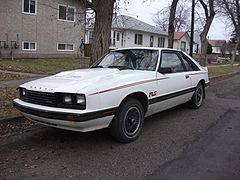
1979–1982 Mercury Capri

1982 Mercury Lynx
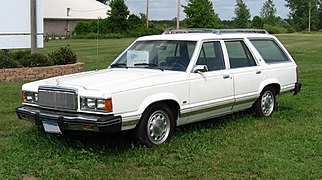
1982 Mercury Cougar GS

1983–1987 Mercury Grand Marquis

1985 Mercury Marquis
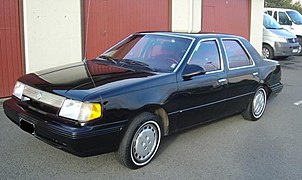
1987 Mercury Topaz

1989 Mercury Sable
Merkur[]
For the 1985 model year, Ford chose to revisit the success of the 1970s Mercury Capri, with participating Lincoln-Mercury dealers launching the Merkur brand. Drawing its name from the German word of Mercury, Merkur sold German-produced captive imports designed by Ford of Europe, competing against European executive cars sold in North America from Audi, BMW, Mercedes-Benz, Saab, and Volvo (along with the launch of Acura).
At its launch, Merkur introduced the Merkur XR4Ti sports coupe, a federalized version of the Ford Sierra XR4i (renamed in deference to General Motors). For the 1988 model year, the Merkur Scorpio was introduced, bringing the Ford Scorpio flagship sedan of Ford of Europe to North America.
Following the 1989 model year, Merkur was discontinued as a result of several factors. The combined model line fell below sales projections, partially due to an unstable exchange rate between the US dollar and the West German mark; at US$25,000 (approximately $52,195 in current dollars), the Scorpio rivaled the Town Car in price, yet bore a close resemblance to the Taurus and Sable.[28] Merkur remains one of the shortest-lived brands in the modern American automotive industry.
Merkur XR4Ti

rear view of Merkur XR4Ti, showing biplane spoiler

Merkur Scorpio

rear view of Merkur Scorpio
1990s[]
As Ford ended the Merkur division in 1989, the Mercury division itself began a major transition during the 1990s. As distinguishing itself from counterpart Ford (and Lincoln) models was a key factor, renewing the model line was imperative. During the 1990s, the division would see major redesigns of its best-selling model lines and would diversify its product line by introducing its first minivan and SUV product lines.
While remaining a counterpart of the Ford Thunderbird, the Cougar underwent a complete redesign for 1989. While remaining the only rear-wheel drive vehicle in its segment (alongside the Thunderbird), its all-new chassis was benchmarked against premium European luxury coupes, allowing for major upgrades to its handling; a much longer wheelbase increased its interior room (inside a slightly smaller body). For the first time, no V8 engine was offered for the Cougar (returning for 1991). At the other end of the size scale, the Mercury Capri was revived (for the second time) as an imported four-seat convertible produced by Ford of Australia. Developed as a competitor to the Mazda MX-5, the Capri was mechanically derived from the Mazda 323 (although the Capri and MX-5 were unrelated to each other).
After a two-year hiatus, the Mercury Tracer returned for 1991 as the smallest Mercury model line. A successor to the previous generation, the Tracer was now a clone of the Ford Escort, as both model lines became near-twins of the Mazda Protegé. The hatchbacks were discontinued, now offered only as a four-door sedan and a five-door station wagon. After 12 years nearly unchanged, the Colony Park wood-trim station wagon was discontinued after a short 1991 model year, losing ground to minivans, full-size vans, and large SUVs.
For 1992, the Mercury model line would undergo an extensive update, introducing new generations of its best-selling model lines. While adopting the style of the successful previous generation (and its chassis), the Sable carried over only its doors and roof. After 12 years nearly unchanged, the Grand Marquis underwent a larger-scale redesign, sharing no body commonality with the previous generation. While the chassis was carried over, it underwent major handling upgrades, marking the introduction of the first overhead-cam V8 engine in an American-brand car. Far more aerodynamic than its predecessor, the exterior of the Grand Marquis was better-received by the marketplace than that of the Chevrolet Caprice and Buick Roadmaster (and the Ford Crown Victoria); sales of the model line doubled from 1991 to 1992, leading it to become the best-selling Mercury sedan through much of the 1990s.
The product of a joint venture with Nissan, the Mercury Villager was launched as a 1993 model as the first Lincoln-Mercury minivan (Mercury never marketed the Ford Aerostar). Deriving its name from Mercury wood-trim station wagons, the Villager was produced by Ford alongside Nissan Quest; both vehicles shared a chassis and engine with the Nissan Maxima. Intended as a competitor to the Chrysler Town & Country and Oldsmobile Silhouette, the Villager was sized between the two sizes of Chrysler minivans. Mercury sales rebounded in 1993 to over 480,000, their highest level since the 1978 all-time high. In the mid-1990s the brand received some free advertising when country music star Alan Jackson scored a hit with a 1993 cover of K. C. Douglas' "Mercury Blues", a song which heaped praise on their vehicles. Ford later used a different version of the song in its truck advertising.[29] It was also this year that television star Kate Jackson came on board as a regional spokeswoman for the Lincoln-Mercury sales division, promoting the Mercury models through the 1997 model year.
As the 1990s progressed, several product changes were less well-received by buyers. Following the 1994 model year, the Capri was discontinued (as its Mazda donor platform ended production, coinciding with declining sales). For 1995, the Topaz was replaced by the Mystique, offered only as a four-door sedan. Derived from the Ford Mondeo "world car", the compact Mystique was developed as a mid-size car outside of North America but was criticized for the small interiors (in comparison to competitive vehicles). For 1996, the Sable underwent a second redesign, with Ford stylists further distinguishing the Sable and Taurus from one another. The redesign was poorly received by critics and buyers, leading to sales to fall by one-third from 1996 to 2000. For 1997, the Tracer was redesigned alongside the Ford Escort; in contrast to the redesign of the Sable, the Tracer differed from the Escort in its grille and badging.
Following the introduction of the Oldsmobile Bravada and the Acura SLX, Mercury introduced the Mercury Mountaineer for 1997, entering the mid-size luxury SUV segment. Derived from the Ford Explorer (itself derived from the Ford Ranger at the time), the Mountaineer differed from the Explorer in its fitment all-wheel drive (rather than four-wheel drive); a V8 engine was standard (initially). The Mountaineer introduced the silver "waterfall grille", a styling theme adopted on nearly all succeeding Mercury vehicles. After overall market demand shifted away from large two-door coupes, 1997 was the final model year for the Mercury Cougar (alongside the Ford Thunderbird).
The discontinuation of the full-size Buick Roadmaster and Chevrolet Caprice by General Motors after 1996 led to an increase in sales of the Grand Marquis, rising nearly 20 percent from 1996 to 1997. For 1998, the model line underwent a mid-cycle redesign; in a more visible update, to appeal to retail buyers, the Ford Crown Victoria adopted the more formal roofline of the Grand Marquis.
1999 marked multiple changes to the Mercury line. After skipping the 1998 model year, the Cougar made its return, becoming its own model line. A second generation of the Villager was introduced; alongside the Nissan Quest, the model line adopted a driver-side sliding door. The sedan line was faced with reduction, as both the Tracer and Mystique were in their final model year.

1989–1990 Mercury Cougar XR7
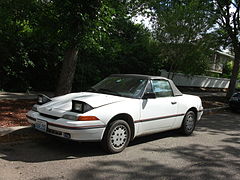
1991–1993 Mercury Capri

1992–1996 Mercury Tracer

1992–1994 Mercury Villager Nautica
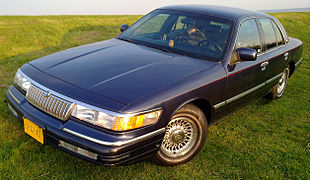
1994 Mercury Grand Marquis LS

Mercury Mystique
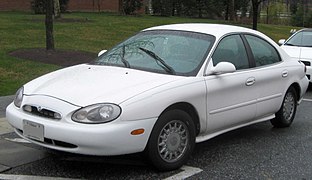
1996–1997 Mercury Sable
Mercury Mountaineer
2000–2011[]
By the beginning of the 2000s, the Mercury division began to struggle in efforts to modernize its brand image. While sales of the Grand Marquis were highly profitable (then its best-selling model line), the mid-60s average buyers' age was nearly two decades higher than what Lincoln-Mercury dealers sought to attract into showrooms.[30][31] Through the 2000s, multiple efforts were made to attract younger buyers to the brand, involving product changes and replacements.
Following the withdrawal of the Tracer and Mystique after the end of 1999, Mercury was left with the Sable and Grand Marquis. For 1999, the Cougar made its return under a completely new model identity, becoming a compact sports coupe. Beginning life as the third-generation Ford Probe, the new Cougar adopted the chassis of the Mystique (becoming front-wheel drive for the first time). In a first for the nameplate, the Cougar was marketed with no Ford equivalent (though badged as a Ford Cougar in export markets). After meeting with initial success (outselling its previous-generation namesake for 1999 and 2000), sales declined; the Cougar was discontinued a final time after 2002 (as Ford shifted to a new generation of the Mondeo).
After the discontinuation of the Cougar, Mercury began a series of model introductions to further expand its model line. After a hiatus of over three decades, the Mercury Marauder made its return, developed as a 2000s competitor to the 1994–1996 Chevrolet Impala SS. Derived from the Grand Marquis, the Marauder was designed with higher-performance suspension and powertrain upgrades (sharing its engine with the Ford Mustang Mach 1). As with the Impala SS, the Marauder was styled with a nearly monochromatic exterior (with most examples produced in black). Due to lack of marketing, the Marauder was discontinued after 2004.
After 2002, Ford ended its joint venture with Nissan to produce the Villager, leaving the division out of the minivan segment. For 2004, the Villager was replaced by a revived Mercury Monterey; a direct counterpart of the Ford Freestar. Introduced as a direct counterpart of the Chrysler Town & Country, the Monterey struggled to establish market sales as the minivan segment in North America declined as a whole; after 2007, the Monterey was discontinued alongside the Freestar.
During 2005 and 2006, three new vehicles were added to the Mercury model line. To bring Lincoln-Mercury its first compact SUV, the Mercury Mariner was introduced as a counterpart of the Ford Escape/Mazda Tribute. The sedan line underwent a major revision, as Mercury replaced the Sable with two different vehicles. The larger sedan, the 2005 Mercury Montego, was a full-size sedan (a counterpart of the Ford Five Hundred); while close in exterior footprint to the Sable, the interior packaging of the Montego more closely matched the Grand Marquis. The smaller sedan, the Mercury Milan (a counterpart of the Ford Fusion) was sized closely to the first-generation 1986 Sable.
Following the discontinuation of the Lincoln Aviator, many of its features were adopted by the Mountaineer SUV as part of its 2006 redesign to further distinguish it from the Ford Explorer.
While the introduction of "F" nameplates by Ford was met with controversy in the mid-2000s, the reaction to "M" nameplates by Mercury for its product range was much less extreme. Before the 1980s, the division had used the practice for many of its product lines; several recognized nameplates were revived by the brand (Marauder, Montego, Monterey). While the Milan was outsold by its Ford Fusion counterpart (by a significant margin), the product line met with relative success, overtaking the Grand Marquis as the best-selling Mercury sedan in 2008. The Montego struggled to gain market share against competitive sedans, partly due to model overlap with the Grand Marquis (in contrast, Ford had long ended marketing for the Crown Victoria and ended retail of the model line after 2007).
In 2008, Ford introduced an advertising campaign starring actress Jill Wagner that focused exclusively on attracting female drivers to the Mercury brand in hopes of making it more relevant and profitable (standing in stark contrast to its late 1960s "The Man's Car" ad slogan).[32][33][34] The campaign was a failure, narrowing the brand image and buyer appeal of the division even deeper, and sales continued to fall. Outsold by the Grand Marquis by nearly five-to-one for 2007, the Montego was renamed the Sable for 2008. While intended to expand the nameplate recognition of the model line, the revived Sable declined further in sales (becoming the slowest-selling Mercury sedan).

2002 Mercury Cougar
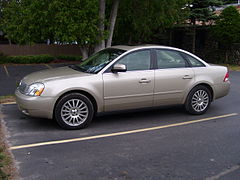
2006 Mercury Montego Premier

Mercury Mariner
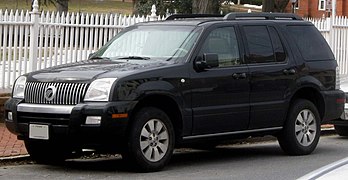
2006-2010 Mercury Mountaineer

2007 Mercury Monterey

2008 Mercury Milan
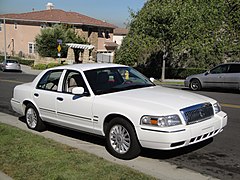
2011 Mercury Grand Marquis
Discontinuation[]

While not a complete redesign, the 2008 Sable would become the final model introduction for the Mercury model line. Through the mid-2000s, Ford began to pare down the Mercury model line, ending the development of direct counterparts of new Ford model lines. Alongside the lack of a Mercury version of the Ford Focus in 2000, no version of the Ford Edge, Freestyle/Taurus X, or Flex entered production (the Edge and Flex were offered by Lincoln as the MKX and MKT, respectively). Except for the Grand Marquis (which had overtaken and replaced the Ford Crown Victoria in retail sales), following the Cougar, each Mercury sedan and SUV was produced with a direct Ford divisional counterpart.
On June 2, 2010, Ford announced the closure of the Mercury line, effective at the end of the year as the company concentrated its marketing and engineering efforts on the Ford and Lincoln model lines.[1] In terms of overall sales in North America, the Mercury brand held a 1 percent share (compared to the 16 percent share of Ford).[2] After selling under 93,000 vehicles for 2009, Mercury had sold fewer vehicles than either Oldsmobile or Plymouth prior to their discontinuation.[35] At the time, Mercury vehicles were sold in the United States, Canada, Mexico, Puerto Rico, U.S. Virgin Islands, and the Middle East. For 2010, 93,165 Mercury vehicles were sold, nearly 265,000 fewer than in 2000.[36]
For its two slowest-selling model lines, Mercury ended the Sable and the Mountaineer after the 2009 and 2010 model years; the two vehicles completed their model cycles without replacement. The Mariner, Milan, and Grand Marquis were produced through the end of 2010 for a shortened 2011 model year. On January 4, 2011, the final Grand Marquis was produced by Ford of Canada as the final Mercury-brand vehicle.[3] As Ford announced the closure of the Mercury brand, signage related to the brand began to disappear from Lincoln-Mercury dealers. To reflect the change completely, the Lincoln division renamed the Lincoln Motor Company (its name before World War II) in December 2012.
Sales figures[]
| Year | 2000 | 2001[37] | 2002[38] | 2003 | 2004[39] | 2005 | 2006[40] | 2007 | 2008[41] | 2009[42] | 2010[43] | Total sales (2000–2010) |
|---|---|---|---|---|---|---|---|---|---|---|---|---|
| Grand Marquis | 122,572 | 112,034 | 80,271 | 79,147 | 76,116 | 64,716 | 54,688 | 50,664 | 29,766 | 24,783 | 28,543 | 723,300 |
| Milan | 5,321 | 35,853 | 37,244 | 31,393 | 27,403 | 28,912 | 166,126 | |||||
| Mariner | 7,171 | 34,099 | 33,941 | 34,844 | 32,306 | 28,688 | 29,912 | 200,961 | ||||
| Mountaineer | 46,547 | 45,574 | 48,144 | 49,692 | 43,916 | 32,491 | 29,567 | 23,849 | 10,596 | 5,169 | 5,791 | 341,336 |
| Montego | 2,974 | 27,007 | 22,332 | 10,755 | 63,068 | |||||||
| Sable | 103,030 | 102,646 | 98,998 | 61,342 | 42,737 | 24,149 | 10,366 | 16,187 | 6,256 | 37 | 465,748 | |
| Marauder | 7,839 | 3,213 | 11,052 | |||||||||
| Mystique | 16,208 | 16,208 | ||||||||||
| Cougar | 40,343 | 29,487 | 19,345 | 2,024 | 91,199 | |||||||
| Villager | 30,443 | 22,046 | 16,442 | 68,931 | ||||||||
| Monterey | 2,213 | 17,407 | 8,166 | 4,467 | 700 | 32,953 | ||||||
| Total Mercury Division sales | 359,143 | 311,787 | 263,200 | 202,257 | 193,534 | 195,949 | 180,848 | 168,422 | 120,248 | 92,299 | 93,195 | Total sales (2000–2010) 2,180,882 |
Mercury in Canada[]
This section needs additional citations for verification. (June 2021) |
During the middle of the 20th century, the small dealership network of Ford Motor Company in Canada necessitated some branding changes to attract buyers into showrooms. This was especially the case in smaller, rural communities in need of trucks, as these areas were served by either a Ford or a Lincoln-Mercury dealer, but rarely both. Mirroring General Motors in Canada, Monarch competed against Oldsmobile while Meteor competed against Pontiac; Mercury trucks competed against GMC.
Following the demise of Edsel and its effects on the Lincoln-Mercury division as well as the Canada–United States Automotive Products Agreement, Ford largely integrated its model lines across the United States and Canada by the end of the 1960s.
Monarch[]

From 1946 to 1957, to attract buyers of medium-price vehicles, Ford of Canada marketed the Monarch brand in their dealership network. Using much of the body and trim of the Mercury, Monarch was a three-model line with the Richelieu, Lucerne and Sceptre matching the Mercury Monterey, Montclair, and Park Lane, respectively.
Ford of Canada replaced Monarch with the Edsel brand for 1958; a poor reception to Edsel in Canada led to the return of Monarch for 1959. The same year, the Ford Galaxie was introduced, shifting the Ford brand upward in price and content; fearing brand overlap with the Galaxie, Ford of Canada ended the Monarch brand after the 1961 model year.
In 1975, the Monarch nameplate would again become associated with Mercury (in both the United States and Canada), becoming the counterpart of the Ford Granada.
Meteor[]
From 1949 to 1976, Lincoln-Mercury of Canada marketed the Meteor nameplate as its lowest-price brand to compete in lower-price markets (most closely against Pontiac). In contrast to the Mercury and the Monarch of the 1950s, which derived their bodies from Lincoln, the Meteor combined a Ford body with a Mercury grille and trim. The brand was marketed as a four-model counterpart of the Ford line (Meteor, Niagara, and Rideau; the Montcalm was added in 1959 to match the Galaxie).
For 1962 and 1963, Lincoln-Mercury of Canada dropped the Meteor brand, coinciding with the introduction of the namesake Mercury product line and as Mercury distanced itself from Lincoln in price at the beginning of the 1960s. In 1964, Meteor was revived in Canada (replacing the Mercury Monterey in the same market). In 1965, Meteor returned the Rideau and Montcalm names, using a Ford Galaxie body with a Mercury grille. For 1967, its equivalent of the LTD was named the Montego, renamed the LeMoyne for 1968 (as Mercury themselves adopted the Montego name).
In 1968, Lincoln-Mercury of Canada added Mercury badging to Meteor vehicles, gradually beginning to integrate Meteor into its model line. After 1976, the Rideau and Montcalm were discontinued, combined as a base Meteor trim level for the Mercury Marquis in Canada; Lincoln-Mercury of Canada dropped the Marquis Meteor after the 1981 model year.

Trucks[]

To increase the availability of its truck lineup in Canada, Ford introduced Mercury-badged trucks in Lincoln-Mercury dealerships in 1946. Initially rebadging the Ford F-Series light trucks as the Mercury M-series, the product range was expanded to include Mercury-badged versions of the medium-duty Ford F-series (and its school bus chassis variant), the C-Series COE truck, and a Mercury version of the Econoline. Sharing nearly identical bodywork with Ford trucks, Mercury-badged trucks were largely distinguished by a division-specific grille and exterior trim and badging.
Sold only in Canada, Ford ended sales of Mercury-badged trucks after 1968 (sales of the Mercury version of the C-Series COE continued through 1972); during the 1960s, the M-series shifted closer in appearance to its Ford counterpart. Following the withdrawal of the M-series, Mercury permanently ended pickup truck production, not marketing another light truck until the 1993 Villager minivan.
Brand identity[]
This section needs additional citations for verification. (June 2021) |
Logo[]
The first logo of the Mercury brand was its namesake, the Roman god Mercury. Towards the early years of the brand, Mercury used its Roman namesake in a silhouette profile (with signature bowl hat with wings, as shown in the image). This logo was briefly revived for 2003–2004, used in the alloy wheel centers of the Mercury Marauder.
In the mid-1950s, Mercury introduced "The Big M", the namesake letter with horizontal extensions at its bottom;[44] at the time, Mercury was a prime sponsor of The Ed Sullivan Show. After 1959, the "Big M" was replaced by a crest emblem. In various forms, Mercury would use a crest emblem on its vehicles through the end of the 1980s. While upper-trim models (such as the Grand Monarch Ghia or Marquis) would feature a crest on the hood or grille, lower-trim models (such as the Monterey or Montego) featured a crest in places such as the wheels. For a time, the Marquis (later Grand Marquis) used a modified version of the Lincoln star emblem.
Following the 1967 introduction of the Mercury Cougar, the branding of Mercury vehicles changed; similar to the Ford Mustang pony emblem, the Cougar adopted its own "prowling cat" logo. During the 1970s, the Cougar became the most popular Mercury vehicle, with a "Sign of the Cat" advertising campaign launched by the division. For 1977, the Cougar logo was revised from a "prowling cat" to a "cat-head" emblem, later adapted by the Mercury Lynx, Mercury LN7 and the Mercury Capri.
In 1984, Mercury introduced what would become its final brand emblem (pictured in the article information box). Centered in the grille, the silver Mercury emblem is a set of three stacked obtuse angles (also in silver). Introduced with the Mercury Topaz, the emblem was adopted by the Lynx and Sable, with the Grand Marquis/Colony Park adopting it in 1988 (on hood ornaments and wheels). In 1999, the emblem saw a minor revision, with the word "Mercury" added to the top half of the emblem. The emblem became the final design featured for a hood ornament of an American-brand automobile, offered as an option for the Grand Marquis for 2005 (for a single year).
- Various Mercury brand emblems, 1939–2011
hood ornament, 1947 Mercury
hood ornament, 1951 Mercury Eight
trunklid badge, 1951 Mercury

"Mercury Head" emblem (1965 Mercury Comet Caliente)

1960s Mercury script (on 1967–1969 Cougar)

1977–1979 Mercury Cougar XR-7 "cat head" hood ornament

Final Mercury emblem (2000–2005 Sable grille)
Grille design[]
The Mercury styling of the brand is most commonly associated with a waterfall-style grille. First making an appearance in the 1946 Mercury Eight, the design was revived in the 1961–1964 Monterey/Colony Park. The design would reappear in the debut of the Mercury Cougar, as designers sought to differentiate the model from the Ford Mustang. During the 1970s, the vertical waterfall grille design was adapted by nearly all Mercury vehicles (except for the Capri and Comet).
In 1986, as part of the introduction of the Mercury Sable and a revision of the Mercury Topaz, the division introduced a "lightbar" front grille. Using low-power light bulbs, the grille between the headlights was illuminated. By 1992, the feature was adapted by all Mercury vehicles (except for the Cougar and Grand Marquis).
In 1997, as part of the introduction of the Mercury Mountaineer SUV, Mercury reintroduced the chrome vertical "waterfall" grille. In place of the radiator-style grille of Lincoln, several grille shapes were initially used, before the division adapted a rectangular grille opening in the mid-2000s.
"Breezeway" roof[]
In 1957, Mercury introduced the Mercury Turnpike Cruiser, featuring a roofline with a retractable rear window. From 1958 to 1960, the feature made its return on the Continental Mark-series line, with a reverse-slant rear window (on both hardtops and convertibles). For 1963, Mercury reintroduced the feature as an option for the Monterey; to streamline production, elements of the window design were shared with Ford station wagons. From 1963 to 1966, the optional reverse-slant roofline with retracting rear window was unique to Mercury, featured by no other American brand.
Branding[]
Following the replacement of the Mercury Eight by the Mercury Monterey in 1952, the division adopted a nameplate nomenclature for its model lines. For the next six decades, the later Montclair, Medalist, Meteor, Marauder, Montego, (Grand) Marquis, Monarch, Mystique, Mountaineer, Milan, and Mariner all used nameplates starting with "M". Beginning the 1967 debut of the Mercury Cougar, several nameplates were derived from big cats, including the Bobcat and Lynx (with the Sable also adopting an animal name).
Mercury woodgrain-trim station wagons used the Villager nameplate, in line with the Ford Squire name. Reviving a nameplate used by Edsel wagons, Mercury used the nameplate for all station wagons from the 1960s to the 1980s (except for the Colony Park). After becoming dormant in the early 1980s, the Villager name returned in 1993 (as the Mercury Villager minivan).
From the 1980s to the 2000s, Mercury adopted a common trim nomenclature across its model lines, with GS standing for a base-trim model and LS as a high-trim version. For performance-oriented trims, XR was used (Cougar XR7, Topaz XR5, and Capri XR3). From the mid to late-2000s, Mercury shifted its trim nomenclature in line with Lincoln, with full words replacing letter-based designations.
See also[]
References[]
- ^ Jump up to: a b "'It's time:' Ford to close Mercury by year's end". USA Today. January 6, 2010. Retrieved June 2, 2010.
- ^ Jump up to: a b Maynard, Micheline (June 2, 2010). "Ford Appears Ready to End Its Mercury Brand". New York Times. Retrieved June 2, 2010.
- ^ Jump up to: a b "Last Mercury rolls off the line as Mercury rolls into history". AutoWeek.com. January 4, 2011. Archived from the original on October 2, 2013. Retrieved January 4, 2011.
- ^ "MERCURY Trademark Details". Justia. Retrieved December 24, 2019.
- ^ Jump up to: a b c d Daniel Vaughan. "1941 Mercury Model 19A news, pictures, and information". Conceptcarz. Retrieved December 2, 2012.
- ^ "The First Mercury". Special Interest Autos. July–August 1974. p. 19.
- ^ Kimes, Beverly (1996). standard catalog of American Cars 1805-1942. Krause publications. p. 961. ISBN 0-87341-478-0.
- ^ 1634 to 1699: McCusker, J. J. (1992). How Much Is That in Real Money? A Historical Price Index for Use as a Deflator of Money Values in the Economy ofthe United States: Addenda et Corrigenda (PDF). American Antiquarian Society. 1700-1799: McCusker, J. J. (1992). How much is that in real money?: a historical price index for use as a deflator of money values in the economy of the United States (PDF). American Antiquarian Society. 1800–present: Federal Reserve Bank of Minneapolis. "Consumer Price Index (estimate) 1800–". Retrieved January 1, 2020.
- ^ Durbin, Dee-Ann; Krisher, Tom (June 2, 2010). "Mercury falling: Ford eliminates mid-range brand". Associated Press. Retrieved August 11, 2017.
- ^ "The Inflation Calculator". Westegg.com. Retrieved October 16, 2017.
- ^ "1941-1948 Mercury". HowStuffWorks. September 11, 2007. Retrieved November 11, 2018.
- ^ Jump up to: a b c "Automotive History: Lincoln's Liquamatic Drive – Failure to Upshift". Curbsideclassic.com. Retrieved November 11, 2018.
- ^ Jump up to: a b c "1941-1948 Mercury". HowStuffWorks. September 11, 2007. Retrieved November 11, 2018.
- ^ "How Mercury Cars Work". HowStuffWorks. June 6, 2007. Retrieved July 15, 2019.
- ^ Jump up to: a b c d e "How Mercury Cars Work". Auto.howstuffworks.com. June 6, 2007. Retrieved July 15, 2019.
- ^ Jump up to: a b c d "Ford Models" (PDF). August 21, 2011. Archived from the original (PDF) on August 21, 2011. Retrieved June 7, 2021.
- ^ "Archived copy". Archived from the original on May 27, 2018. Retrieved May 26, 2018.CS1 maint: archived copy as title (link)
- ^ Jump up to: a b "How Mercury Cars Work". HowStuffWorks. June 6, 2007. Retrieved July 19, 2019.
- ^ Jump up to: a b c d "How Mercury Cars Work". HowStuffWorks. June 6, 2007. Retrieved July 20, 2019.
- ^ "1961 Lincoln Continental". HowStuffWorks. October 11, 2007. Retrieved December 1, 2019.
- ^ Jump up to: a b "1961 Lincoln Continental". HowStuffWorks. October 11, 2007. Retrieved December 1, 2019.
- ^ "1961 Lincoln Continental". HowStuffWorks. October 11, 2007. Retrieved November 24, 2018.
- ^ "How Mercury Cars Work". HowStuffWorks. June 6, 2007. Retrieved December 1, 2019.
- ^ Jump up to: a b c d "How Mercury Cars Work". HowStuffWorks. June 6, 2007. Retrieved July 4, 2019.
- ^ "Box Panther Production Numbers". Grandmarq.net. Retrieved July 4, 2019.
- ^ Canada Buys Taiwan Tracers Archived December 19, 2013, at the Wayback Machine, Taiwan Info, July 14, 1986
- ^ "How Mercury Cars Work". HowStuffWorks. June 6, 2007. Retrieved July 6, 2019.
- ^ Ltd, Earl G. Graves (November 1988). Black Enterprise. Earl G. Graves, Ltd.
- ^ "K.C. Douglas | Biography & History". AllMusic. Retrieved June 7, 2021.
- ^ "Car Buyers Average Age by Make/Model". forum.woodenboat.com. Retrieved November 30, 2020.
- ^ "Archived copy". Archived from the original on May 26, 2013. Retrieved April 7, 2013.CS1 maint: archived copy as title (link)
- ^ "Archived copy". Archived from the original on December 26, 2013. Retrieved December 26, 2013.CS1 maint: archived copy as title (link)
- ^ "Archived copy". Archived from the original on December 26, 2013. Retrieved December 26, 2013.CS1 maint: archived copy as title (link)
- ^ "Archived copy". Archived from the original on December 27, 2013. Retrieved December 26, 2013.CS1 maint: archived copy as title (link)
- ^ Raja, Siddharth (September 3, 2007). "Mercury ever closer to getting the axe". Autoblog.com. Retrieved December 4, 2009.
- ^ "Archived copy" (PDF). Archived from the original (PDF) on January 24, 2011. Retrieved 2011-01-04.CS1 maint: archived copy as title (link)
- ^ "Ford Motor Company's December 2001 U.S. Sales Rise 2.0 % Compared With Year Ago" (Press release). January 3, 2002. Archived from the original on July 10, 2012. Retrieved January 7, 2012.
- ^ "Ford's F-Series Truck Caps 22nd Year in a Row as America's Best-Selling Vehicle With a December Sales Record". Theautochannel.com. November 17, 2004. Retrieved April 28, 2009.
- ^ "Ford achieves first car sales increase since 1999". Theautochannel.com. January 4, 2006. Retrieved April 28, 2009.
- ^ "Ford Motor Company 2007 sales". January 3, 2008. Archived from the original on February 12, 2009.
- ^ "F-Series drives ford to higher market share for third consecutive month" (PDF). Ford Motor Company. January 5, 2009. Archived from the original (PDF) on February 6, 2009. Retrieved 2009-05-14.
- ^ "Archived copy". Archived from the original on August 26, 2010. Retrieved 2010-12-24.CS1 maint: archived copy as title (link)
- ^ "Archived copy" (PDF). Archived from the original (PDF) on January 24, 2011. Retrieved 2011-01-04.CS1 maint: archived copy as title (link)
- ^ "1956 Mercury Montclair Sport Hardtop Coupe photo – Ken Leonard photos at". Pbase.com. Retrieved December 4, 2009.
External links[]
| Wikimedia Commons has media related to Mercury (automobile). |
- Official website at the Wayback Machine (archived November 20, 2010)
| show |
|---|
| show |
|---|
- Mercury (automobile)
- Car manufacturers of the United States
- Ford Motor Company
- Defunct motor vehicle manufacturers of the United States
- Motor vehicle manufacturers based in Michigan
- Premier Automotive Group
- 1938 establishments in Michigan
- American companies established in 1938
- 2011 disestablishments in the United States
- Vehicle manufacturing companies established in 1938
- Vehicle manufacturing companies disestablished in 2011
- American brands
- Ford Motor Company Marques
- Luxury motor vehicle manufacturers











































